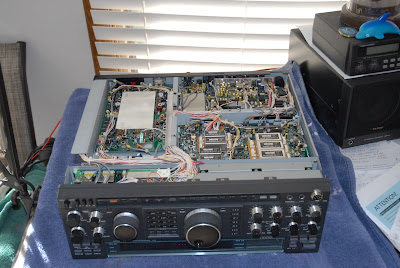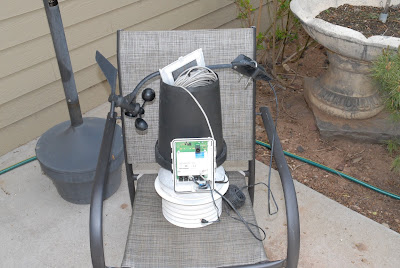But I got two 4x4x8 posts and three 8' ground rods inside the Jeep, along with the ground rod driver bit, two bags of dense shade/bright sun grass seed, six bags of soil, 1 cuft each, 3 bags of QuickCrete, and some other misc stuff, without punching out my new stereo or ripping up the dash.
I could have fit the auger in there, but no joy at Harbor Freight. I picked up several 4" magnetic parts dishes (never have enough of them!), a new "Bauer" True RMS Digital Multimeter for the garage, another magnifying lamp to clamp on this radio desk so when the wife or The Little Guy wander up with something to "fix" I can see what I'm doing, a combination tire inflator/gauge with a nice hose whip on it to replace my $6 HF hose whip that disintegrated after 10 years, some air fittings, and some of the HF "Thunderbolt" AA and AAA batteries.
And I shopped air compressors and floor jacks while I was there. These are two items I "need" replacements for, as my little "air compressor" is barely good enough for filling tires and blowing (light) dust off things, and my aluminum "1.5 Ton" rated floor jack struggles to lift ONE front corner of the Jeep. These are the "1.5" ton aluminum "Racing Jacks" you see for $60 at HF, and that's about what they're worth. It picks up the Supra and the wife's Hyundai Elantra just fine, but starts to grunt lifting the rear end of the Jeep, and really groans picking up ONE front corner. The wife agrees 100% about the jack, seeing as it's a Safety Item, so I know which one I'm buying "As Needed". It's a 3 ton, low-profile, long-reach model, and even has a foot pedal to pump it up, something I haven't seen on a big floor jack in like forever.
Air compressors are another matter. The little "hot dog" (one small tank) oil free compressor I have is better suited for an air brush than garage duty, but I'm severely spaced constrained. If I clean off the bottom shelf of the workbench, I *think* I can fit one of these down there:
Otherwise I'll have to get something like this:
Since I won't be running air tools, I can squeak by with one of these small jobs. The highest air demand will be from the small touch-up spray gun I have, and these two compressors are rated to deliver more air than the gun requires. And either one will be far better for tires and blow-gun stuff than the itty-bitty compressor I have now.
So no hole digging this weekend, and I'll use the time to get Ms. Swan out of the garage so I can sweep it out and do some shelf reorganization that'll require the ladder on that side of the garage.





















